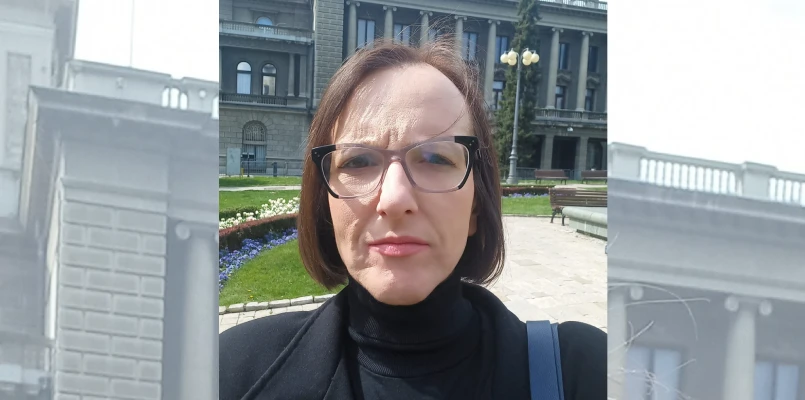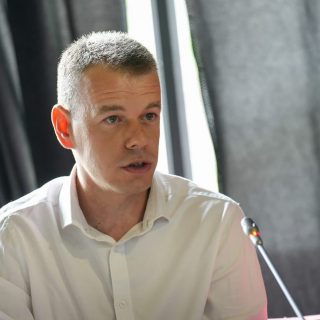Images from the war-torn Ukraine have reminded many of us of the bloody breakup of Yugoslavia. The images of destroyed cities and villages, men in uniforms, women and children in lines of refugees, statements of male politicians appearing on TV on a daily basis and giving ominous warnings about the possibility of an even greater destruction, including the use of nuclear arms, are characterised by a sinister similarity. In our region, there is a saying ”War is a racket – some profit, some pay”. And indeed, without any intent to idealise women as such, statistical data and research show that women are rarely asked about their opinion during or about a war, but certainly pay a high price during every armed conflict simply because of the fact that they are women.
Today, while we are living in alleged peace in the post-Yugoslav earthquake belt, we should remind ourselves that the main warring parties, irrespective of the different level of responsibility, were the ethno-nationalist parties with extremely patriarchal and misogynist views of gender roles. As a result, the number of female MPs at parliaments in all former Yugoslav republics dropped sharply immediately before the start of the armed conflict and reached the level of a statistical error. According to Žarana Papić, in Croatia it amounted to 4.5%, in Montenegro to 4%, in Macedonia to 3.3%, in Bosnia and Herzegovina to 2.9%, in Serbia even to 1.6%. Subsequently, women did not participate in any peace negotiations, and most of such negotiations were doomed to fail in advance due to the politics of male leaders. At the same time, there was a sharp increase in domestic violence, and during the war, some women were killed in their homes or even in the street by their partners, who used cold weapons or firearms. Even after the war, they hesitate to speak about the violence they survived and were exposed to. They frequently silently put up with the violence, if their partners were on the front lines. Women were raped, degraded and humiliated in any possible way, and the primary intent was to humiliate the opponent through their bodies. However, their traumas are not being treated in a systematic manner, but rather with the assistance of NGOs that do not receive sufficient support for their work. Female survivors are frequently stigmatised by their family members and their environment, and their suffering is abused for further inter-ethnic conflicts and creation of resentment. For this reason, it is impossible to determine the exact number of raped women in Bosnia and Herzegovina. According to some estimates, there are as many as 50 000 women.
However, women were also actors and they started building peace even during the war. They helped other people, saved their neighbours, were active in providing humanitarian aid and different forms of psychological assistance. After the war, they were the first to cross inter-entity borders, establish the initial communication and dialogue, helped returnees as their fellow humans, but also regarding legal issues. It seems that women are here to build peace in the field, but neither war nor peace have a woman’s face, but only the outlines. Female victims are treated as collateral damage, and their contribution to peace building is not taken into account, it is even frequently criticised. As an example, it is sufficient to mention Žene u crnom from Belgrade, a group that raised their voices against patriarchy, nationalism and militarism as early as in 1991. Over the past three decades, they have held more than thousand peace performances, campaigns and demonstrations in almost impossible circumstances and hostile environment. They stood in a square of the capital of Serbia peacefully and persistently, while passers-by frequently hurled insults such as traitors, alarmists in black, lesbians, whores, at them. Members of Žene u crnom have continuously reminded the authorities in Belgrade of the need for facing the truth and assuming responsibility for the events during the 1990s wars.
In this respect, it may be said that women’s organisations are the only ones that tried pointing out the specific experience of women during the war and in the post-war period and finding solutions. Just as a female activist said, everything that could have happened to women during the war has indeed happened. Mass rape, loss of jobs, disappearance from the political arena and exposure to violence and discrimination. And while during the war period this violence was direct, in the post-war period it is primarily structural and cultural. Structural violence is reflected in the different forms of inequality and discrimination, and cultural violence is reflected in the patriarchal values that are used to justify the current state of affairs. These issues are not only related to women, but also to the progress of the whole society that does not acknowledge and value women’s resources. They are also related to peace, given the link between domestic violence and violence in the streets and unequal distribution of power and aggression, frustration and so-called toxic masculinity.
As regards the phenomenon itself, it seems that there are more women now in different spheres that are important for the society, but it is a form of shrewdness of the patriarchy. Namely, in politics, certain female faces are kept in the foreground, but they mostly reproduce ethno-nationalist matrices and imitate the male political role models through pronounced aggressiveness and competition. The goal is to convince the public that equal participation of women in politics does not lead to any changes. Women who offer different models in politics are insufficiently visible in the media and the public arena. There are also more women in decision making positions, such as those in the education sector. However, education has lost its value and the social prestige it used to have. Furthermore, various gender equality action plans and strategies are adopted, including also the UN Resolution 1325 – Women, Peace, Security. However, they are mostly not adequately implemented due to a lack of will and insufficient budget. Many conventions and declarations related to women’s issues that have been signed have no legal effect, and those who signed them, but also the public-at-large, do not know what has been signed and what are the obligations of the state. Patriarchal and nationalist values are still being reproduced through educational and media content with the more or less deliberate aim to prevent a potential danger that the disempowered group might understand in which ways it is disempowered. Abortion is not prohibited, but this topic is such a taboo in the society that it is questionable to what extent women are truly able to exercise their reproductive rights and be autonomous.
In such unfavourable conditions, women’s peace stories, messages and voices and numerous activities are mostly unnoticed. They are a footnote in the history and our social awareness that reflects the social relations of inequality, capture and forgetting women. In addition to this, some activities are implemented on purpose without a major participation of the public due to the danger of political and other types of abuse, which can be seen several times every year during different commemorations. Some are tolerated or even given public space in order to be able to say, we have built peace, too.
At this point, we should remember the importance of the Women’s Court – Feminist Approach to Justice that was held in Sarajevo in 2015. It has a regional dimension and aims to show that neither international nor national courts have brought justice for women in the former Yugoslavia. The main methodology of the court is providing women with opportunities to speak up, motivating them to find their way to deal with trauma and strengthening marginalised voices of women whose suffering is not acknowledged in the public due to a hierarchical approach (some victims are more valuable than others). As a result, there is the so-called horizontal writing of the alternative history of women, as pointed out by Staša Zajović.
The other initiative is Peace with a Woman’s Face that has gathered women’s organisations from both entities in Bosnia and Herzegovina, since the prevailing ethno-nationalist narratives do not enable women to speak up, especially if they are talking about peace and transcend ethnic divisions. Authentic stories of women about their personal losses during the war that motivated them to engage in peace building activities create the potential for the healing of the society. It is also a way to fight the selective culture of remembrance that administers trauma through a top down approach, with the aim to further encourage conflicts and maintain the ethno-nationalist elites in power. Activities implemented by the association Zaboravljena djeca rata are particularly important. The association gathers children that were born as a result of conflict-related sexual violence for the purpose of eliminating the anonymity and exercising the rights of children and mothers, whose rights are being violated in the period of peace. For this purpose, an exhibition entitled Breaking free is being organised. It carries an particularly strong and emotional peace message.
Prof. Zlatiborka Popov-Momčinović, PhD is an Associate Professor of Political Sciences. The focus of her research lies on the women’s movement, political representation of women and the role of religion in peace building. She actively supports the fight for the rights of persons with disabilities and the LGBT community in Bosnia and Herzegovina. In her free time, she is learning foreign languages.




